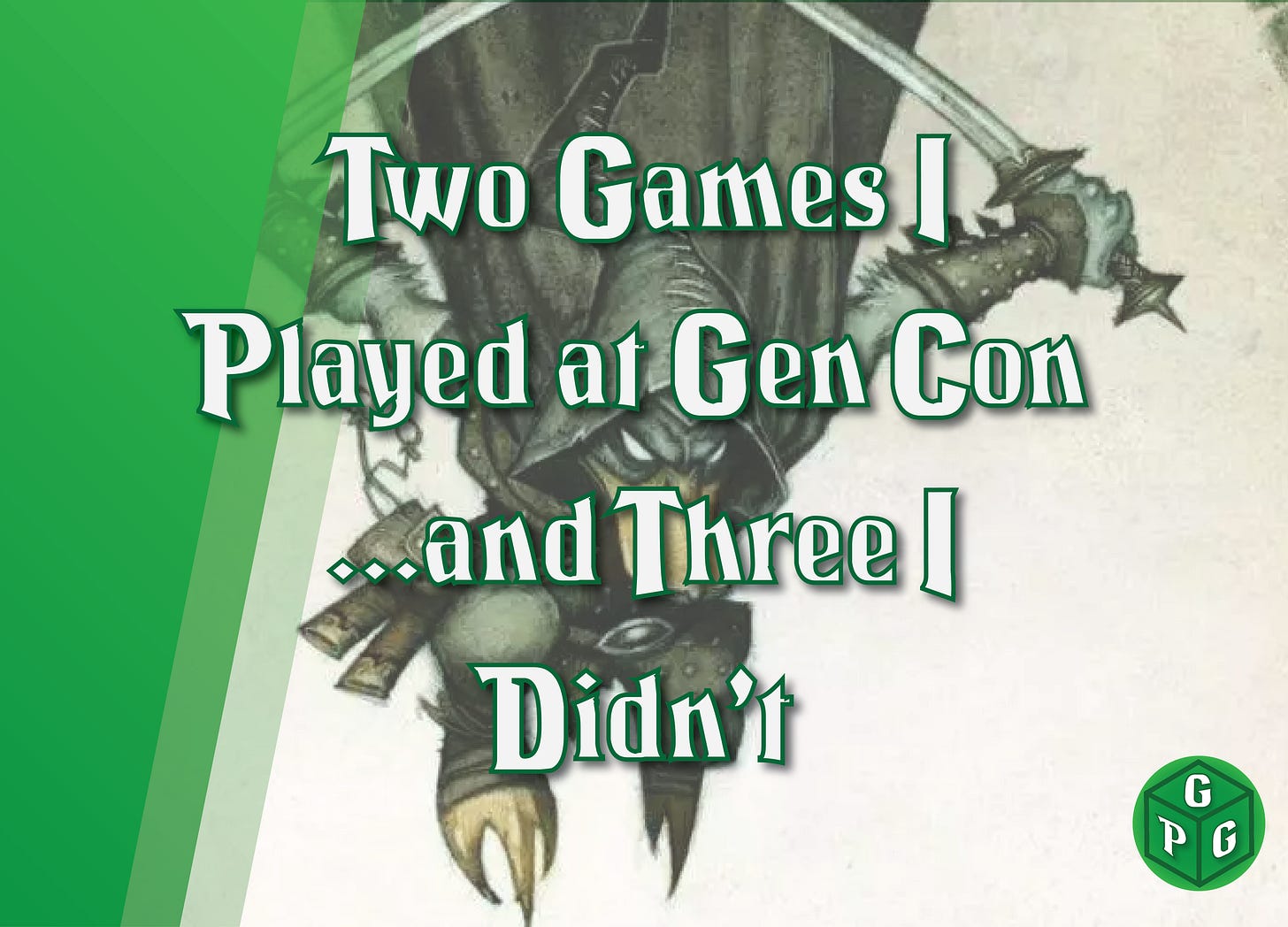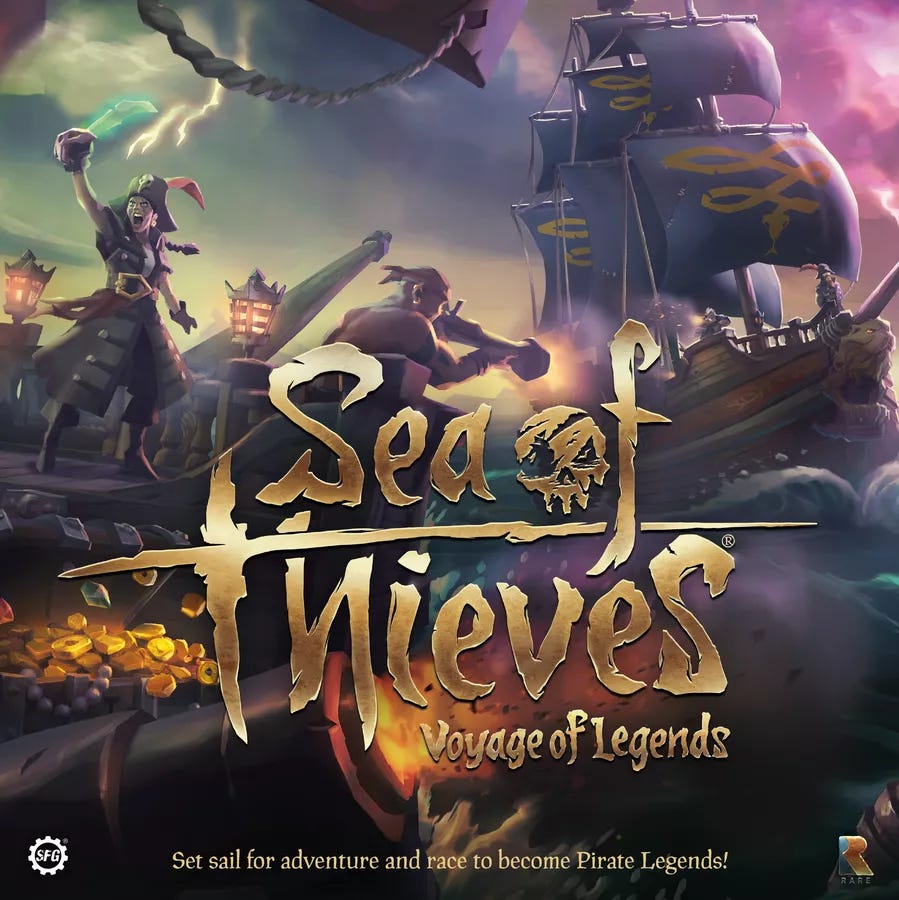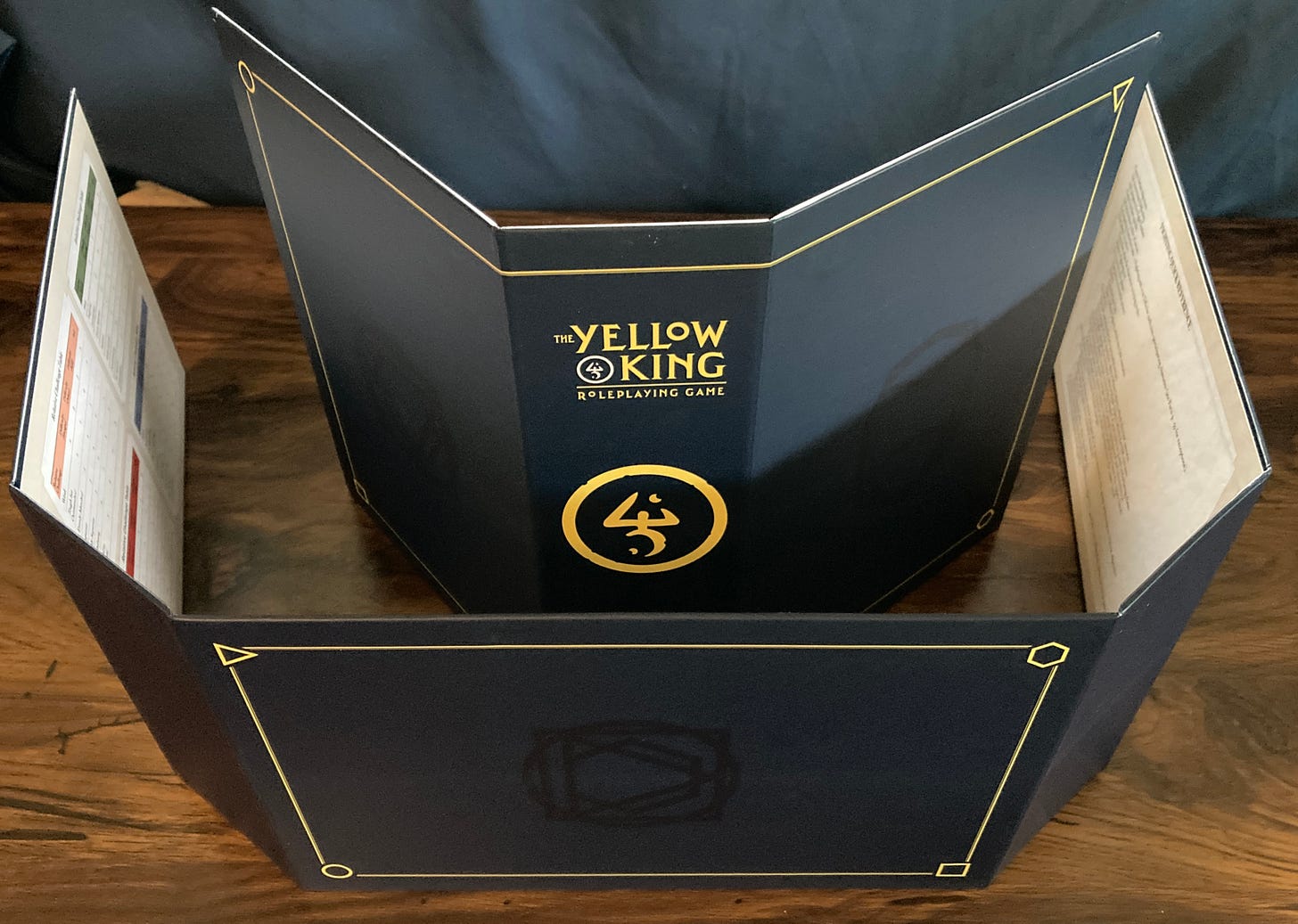I did not expect all of August to be Gen Con month, but it turns out I had a lot more thoughts over those four days in Indianapolis than I realized. This will be the last installment of my series on Gen Con, I promise. So, let’s wrap things up by talking about the most important par t of Gen Con: the games.
Dragonbane
I had hoped to try Dragonbane, the new RPG by Swedish publisher Free League, at the con, but it was not to be. A new edition of one of Sweden’s oldest RPGs, Drakar och Demoner, and released in English for the first time (popularly, though there was a lesser-known adaptation called Ruin Masters a couple of years ago), Dragonbane promised an old-school experience previously unknown to the English-speaking world.
Free League were offering one-hour demos (closer to 30 minutes, according to the sign) every hour on the hour all four days of the con. This was perfect for me, who didn’t have three to four hours to play a full-length RPG session. Unfortunately, they did not offer tickets to these events, unlike every other event at the Con. Worse still, their demos took place at ONE table with a max limit of FIVE players. So even though demos were offered frequently, the number of people served was actually very small. By a very generous estimate, if they had offered 12 games a day for four days, that means that about 240 people would have been able to play this game over the weekend...out of 70,000 attendees!
I cannot fathom why they would decide to advertise their new flagship product in this way. Perhaps there was not enough staff to run it, perhaps they didn’t expect it to be popular (which would be strange, considering the MAS SIVE banners advertising Dragonbane all over the convention center), or perhaps their energy was being spent on pushing the ENNIE award-winning Bladerunner RPG (which, honestly, would also have been cool to try out). They certainly had a LOT more tables running Bladerunner than Dragonbane in their dedicated showroom.
So I was unable to play the game, despite my interest, because they were not interested in sharing it. In any case, the quickstart is free online, and I plan to peruse it in the near future. The starter set is also now available for purchase online and in stores. I’d tell you if it was any good or not, but I have no way of knowing.
Fluffy Dragons
Playing small indie games that have yet to gain any traction is a real treat, and I managed to find one while lingering in the “open play” area, where rows and rows of tables were left open for anyone to sit down and play a pick-up game. I was invited by two individuals representing LAMF Games who wanted to share their upcoming project, Fluffy Dragons, which they plan to fund through Kickstarter.
The game was very early in development and neither the game board nor the pieces were finished yet. The board was a cut-out paper circle with five symbols representing five elements drawn on it, and the pieces were animal-shaped meeples from another board game. The promo art was well under way however, and depicted cute little dragons with fuzzy designs that rendered them neither mammal nor reptile - perhaps something in the platypus family of weird mammals?
Each player started with a handful of colored gems and five cards representing the elements water, fire, earth, air, and electricity. The game was a take on rock, paper, scissors, lizard, Spock, where each element trumped two other elements, but were weak against the remaining two. The game board also depicted these five elements in an easy-to-read circle so that you always new which elements trumped which.
Players would take turns placing their dragons on one of these five elements and were required to place down the corresponding card from their hand. The trick was that you could lie about the element you chose. If you placed a card of a different element without being caught, you could claim that element at the end of the round and get the drop on the other players. This added a layer of deception similar to games like BS and Mafia.
Skeptical players could call you out by wagering their gems against yours. At the end of a round, when all players reveal their cards, anyone caught lying must forfeit two of their gems to those who called them out. If you were honest, then those who called you out forfeit their wagered gems to you instead.
Afterwards, all players place their dragons on the “true” element on their card and the rock, paper, scissors tally takes place, with losers giving up tokens to the winning players.
It was a pretty fun party game, and while I usually hate lying in games, I didn’t mind it here. It contained enough strategy to keep it interesting. I could see breaking out Fluffy Dragons at family gatherings for a quick game. In any case, I was glad I was able to try it out. The designer, Luis, was super friendly and very good at explaining the rules, which felt overwhelming at first (especially when it came to scoring), but were very simple in practice. I wish LAMF Games the best as they bring this game to life.
Sea of Thieves: Voyage of Legends
I did not get to PLAY Sea of Thieves: Voyage of Legends, but it was one of the few demos on the show floor that I stopped and watched. Steam Forged Games were offering free gifts to anyone who visited their booth which, as you might already know, is a fail-proof way to lure me to a secondary location (the gifts turned out to be poker chips with images from their Epic Encounters line on them).
Sea of Thieves: Voyage of Legends is a board game based on the video game Sea of Thieves, thus the distinguishing subtitle. In Voyage of Legends players take control of pirate crews sailing a chain of islands, looting them for treasure, and competing with each other for fame. Players can create problems for players on other islands by playing cards from their hand, problems like hordes of saber-rattling skeletons or sharks that attack their ship. What I found interesting, mechanically, is that ships could and would often sink, losing their treasure in the sea. When this happened, players would have to “respawn” by creating a new ship, and could retrieve their lost loot if they returned to the spot of their previous wreckage before their opponents. I found this tabletop adaptation of a clearly video game-based mechanic fascinating.
I wondered what the end game was if players could respawn, and the demonstrator told me that they were tracking “fame.” The goal was to maximize your fame before your opponents. In this way, losing a ship was simply a setback, and most mechanics were built around increasing your fame while decreasing your rivals’. Those with much lower fame than their opponents would have more opportunities to catch up with special bonuses, turning the game into a tug-of-war as players fought to stay ahead of their opponents.
The demo I saw was short, less than ten minutes, but it left me with a positive impression of a game that I otherwise had no interest in. It made me realize how important even a small demonstration can be in generating interest, and I am truly sorry I did not stop more often to watch similar demonstrations on the trade floor.
SpyxFamily: Mission for Peanuts
SpyxFamily is a popular anime series about a James Bond-like spy who, in order to investigate a shady politician, forms a fake family in order to establish a cover identity. Unbeknownst to him, his pretend wife is a deadly political assassin and his adopted daughter is actually a telepath who really wants to see this pretend family become a real one. These three try to live their double lives while hiding their true identities from each other and the people around them. Comedy ensues.
The card game is a loose adaptation, using the characters of the show to represent the games different card types. Mechanically, Mission for Peanuts is identical to the card game Love Letter, with a few unique twists. The rules of Love Letter are simple: there are ten card types numbered zero through nine, each one depicting a different character. Each card has a special ability written on it, things like “look at the top three cards of the deck and put them back in whatever order you’d like” or “steal a card from another players hand.” There are multiples of each card, though different cards have different numbers of duplicates. Players start with one card in their hands, and take turns drawing from the deck and then playing one of their two cards. The goal is to knock the other players out of the game, or have the highest-value card in your hand when the deck runs out.
The original Love Letter is a simple party game. Once you learn what all the cards do, it becomes easy to figure out the optimal strategies, after which it starts to feel repetitive. SpyxFamily improves upon Love Letter in a number of ways. For one, cards have two effects each - passive and active - and you may choose either one when playing from your hand. You may only have one passive card in play at a time, but once played it stays on the field until you replace it with another. Furthermore, different card combinations give different point values, meaning you can win by building specific hands. For example, if you ever get Anya, Yor, and Loid (the main characters of the series) in your hand at the same time, you immediately win the round.
I had a fun time in the 15 minute game I played. Two of my opponents lost when the “assassin” card (portraying Yor Forger) was forcibly placed in their hand by the “informant” card, triggering its passive effect, which is to eliminate anybody who receives it from somewhere other than the deck. While my playtime was short, my impression was that the game improves on the Love Letter formula, and could be a fun party game for fans of the SpyxFamily franchise and casual players alike.
The Yellow King RPG
Last and probably not least, The Yellow King RPG is the most expensive thing I bought at Gen Con. I bought it at the insistence of a friend, who also guaranteed that it would be sold out before the end of the Con (I don’t think that ended up happening. I distinctly remember seeing the display game sitting on the table on the last day).
The premise is simple enough. It uses Pelgrane Press’ “Gumshoe” engine, which is built around rewarding investigation. Unlike some games where a bad die roll means you learn nothing and are therefore stuck with an unsolvable mystery, Gumshoe is built to create mysteries where players are constantly finding new clues that lead to new paths of investigation but have to work to bring those clues together and solve the mystery. Other games that use the system include the child-detective game Bubblegumshoe, the eldritch investigation game Trails of Cthulhu, and the new ENNIE award-winning fantasy RPG, Swords of the Serpentine.
The King in Yellow is similar to the Cthulhu mythos of H.P. Lovecraft, but is actually based on stories by Robert W. Chambers. Chambers and Lovecraft were contemporaries and friends, and their mythos bled into each other quite a bit. Where Lovecraft’s stories focused on fearsome unknowable creatures that imposed their will on our world, Chambers’ stories were more about strange other dimensions and blurring the line between reality and delusion.
As such, The Yellow King RPG takes place in four different “other worlds,” with each book in the four-book series dedicated to a different setting. The first book, “Paris,” is straightforward, covering the adventures of American art students studying in 19th-century Paris and investigating eldritch horrors on the side. Book two, “The Wars,” covers a weird alternate-history World War I, where mechanical monstrosities haunt the trenches. Book three, “Aftermath,” takes place in an alternate-history post-fascist America where mutant experiments roam the country. The last book, “This is Normal Now,” is an alternate present were the weird and mundane rub shoulders in ways that are considered normal. These four books can be played separately or strung together in a mind-bending campaign of madness.
That premise is super mysterious and interesting, but the thing that really convinced me to drop $100 on this set was the fantastic packaging. The books themselves are nice, wrapped in solid hardcover bindings with simple but colorful spines that remind me of old hardback novels in grade school (the covers gave me really strong Nancy Drew or Boxcar Children vibes, which is pretty funny given the subject matter). The real prize is the slipcase. It appears normal at first, but closer inspection reveals that it is a fully-functional GM screen held into a box shape by sturdy magnets. This multi-purpose use is fantastic, and something I would LOVE to see more books (RPGs or otherwise) use.
I did not get to play The King in Yellow - at Gen Con or at home - but I look forward to reading these mysterious books, and maybe even running a game one day with that magical GM screen slipcase.














Oh, this is so cool! I'm very glad you enjoyed the game! And thank you so much for sharing your experience! :D